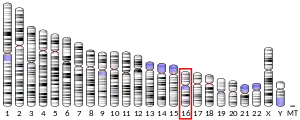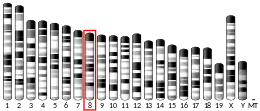BANP
Protein BANP is a protein that in humans is encoded by the BANP gene.[5][6][7] It is a member of the human gene family, "BEN-domain containing", which includes eight other genes: BEND2, BEND3, BEND4, BEND5, BEND6, BEND7, NACC1 (BEND8), and NACC2 (BEND9).
Function
This gene encodes a protein that binds to matrix attachment regions. The protein functions as a tumor suppressor and cell cycle regulator. Alternate transcriptional splice variants, encoding different isoforms, have been characterized.[7]
References
- GRCh38: Ensembl release 89: ENSG00000172530 - Ensembl, May 2017
- GRCm38: Ensembl release 89: ENSMUSG00000025316 - Ensembl, May 2017
- "Human PubMed Reference:". National Center for Biotechnology Information, U.S. National Library of Medicine.
- "Mouse PubMed Reference:". National Center for Biotechnology Information, U.S. National Library of Medicine.
- Birot A, Duret L, Bartholin L, Santalucia B, Tigaud I, Magaud J, Rouault J (Aug 2000). "Identification and molecular analysis of BANP". Gene. 253 (2): 189–96. doi:10.1016/S0378-1119(00)00244-4. PMID 10940556.
- Chattopadhyay S, Kaul R, Charest A, Housman D, Chen J (Aug 2000). "SMAR1, a novel, alternatively spliced gene product, binds the Scaffold/Matrix-associated region at the T cell receptor beta locus". Genomics. 68 (1): 93–6. doi:10.1006/geno.2000.6279. PMID 10950932.
- "Entrez Gene: BANP BTG3 associated nuclear protein".
External links
- Human BANP genome location and BANP gene details page in the UCSC Genome Browser.
Further reading
- Hillier LD, Lennon G, Becker M, Bonaldo MF, Chiapelli B, Chissoe S, Dietrich N, DuBuque T, Favello A, Gish W, Hawkins M, Hultman M, Kucaba T, Lacy M, Le M, Le N, Mardis E, Moore B, Morris M, Parsons J, Prange C, Rifkin L, Rohlfing T, Schellenberg K, Bento Soares M, Tan F, Thierry-Meg J, Trevaskis E, Underwood K, Wohldman P, Waterston R, Wilson R, Marra M (Sep 1996). "Generation and analysis of 280,000 human expressed sequence tags". Genome Research. 6 (9): 807–28. doi:10.1101/gr.6.9.807. PMID 8889549.
- Kaul R, Mukherjee S, Ahmed F, Bhat MK, Chhipa R, Galande S, Chattopadhyay S (Feb 2003). "Direct interaction with and activation of p53 by SMAR1 retards cell-cycle progression at G2/M phase and delays tumor growth in mice". International Journal of Cancer. 103 (5): 606–15. doi:10.1002/ijc.10881. PMID 12494467. S2CID 22386279.
- Brandenberger R, Wei H, Zhang S, Lei S, Murage J, Fisk GJ, Li Y, Xu C, Fang R, Guegler K, Rao MS, Mandalam R, Lebkowski J, Stanton LW (Jun 2004). "Transcriptome characterization elucidates signaling networks that control human ES cell growth and differentiation". Nature Biotechnology. 22 (6): 707–16. doi:10.1038/nbt971. PMID 15146197. S2CID 27764390.
- Kaul-Ghanekar R, Jalota A, Pavithra L, Tucker P, Chattopadhyay S (2004). "SMAR1 and Cux/CDP modulate chromatin and act as negative regulators of the TCRbeta enhancer (Ebeta)". Nucleic Acids Research. 32 (16): 4862–75. doi:10.1093/nar/gkh807. PMC 519105. PMID 15371550.
- Kaul-Ghanekar R, Majumdar S, Jalota A, Gulati N, Dubey N, Saha B, Chattopadhyay S (Mar 2005). "Abnormal V(D)J recombination of T cell receptor beta locus in SMAR1 transgenic mice". The Journal of Biological Chemistry. 280 (10): 9450–9. doi:10.1074/jbc.M412206200. PMID 15623522.
- Jalota A, Singh K, Pavithra L, Kaul-Ghanekar R, Jameel S, Chattopadhyay S (Apr 2005). "Tumor suppressor SMAR1 activates and stabilizes p53 through its arginine-serine-rich motif". The Journal of Biological Chemistry. 280 (16): 16019–29. doi:10.1074/jbc.M413200200. PMID 15701641.
- Rampalli S, Pavithra L, Bhatt A, Kundu TK, Chattopadhyay S (Oct 2005). "Tumor suppressor SMAR1 mediates cyclin D1 repression by recruitment of the SIN3/histone deacetylase 1 complex". Molecular and Cellular Biology. 25 (19): 8415–29. doi:10.1128/MCB.25.19.8415-8429.2005. PMC 1265755. PMID 16166625.
- Rual JF, Venkatesan K, Hao T, Hirozane-Kishikawa T, Dricot A, Li N, Berriz GF, Gibbons FD, Dreze M, Ayivi-Guedehoussou N, Klitgord N, Simon C, Boxem M, Milstein S, Rosenberg J, Goldberg DS, Zhang LV, Wong SL, Franklin G, Li S, Albala JS, Lim J, Fraughton C, Llamosas E, Cevik S, Bex C, Lamesch P, Sikorski RS, Vandenhaute J, Zoghbi HY, Smolyar A, Bosak S, Sequerra R, Doucette-Stamm L, Cusick ME, Hill DE, Roth FP, Vidal M (Oct 2005). "Towards a proteome-scale map of the human protein-protein interaction network". Nature. 437 (7062): 1173–8. doi:10.1038/nature04209. PMID 16189514. S2CID 4427026.
- Kimura K, Wakamatsu A, Suzuki Y, Ota T, Nishikawa T, Yamashita R, Yamamoto J, Sekine M, Tsuritani K, Wakaguri H, Ishii S, Sugiyama T, Saito K, Isono Y, Irie R, Kushida N, Yoneyama T, Otsuka R, Kanda K, Yokoi T, Kondo H, Wagatsuma M, Murakawa K, Ishida S, Ishibashi T, Takahashi-Fujii A, Tanase T, Nagai K, Kikuchi H, Nakai K, Isogai T, Sugano S (Jan 2006). "Diversification of transcriptional modulation: large-scale identification and characterization of putative alternative promoters of human genes". Genome Research. 16 (1): 55–65. doi:10.1101/gr.4039406. PMC 1356129. PMID 16344560.
This article is issued from Wikipedia. The text is licensed under Creative Commons - Attribution - Sharealike. Additional terms may apply for the media files.



